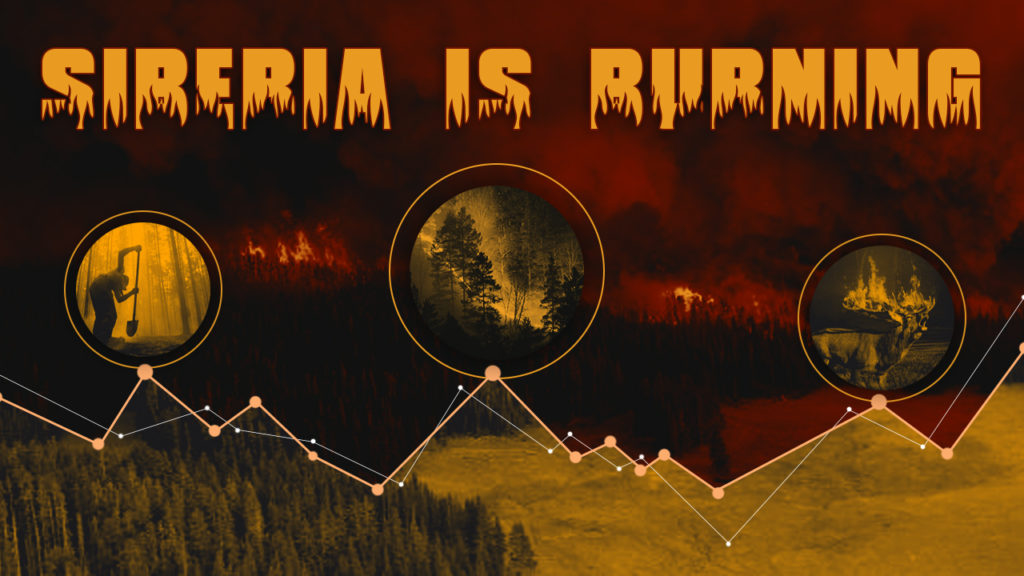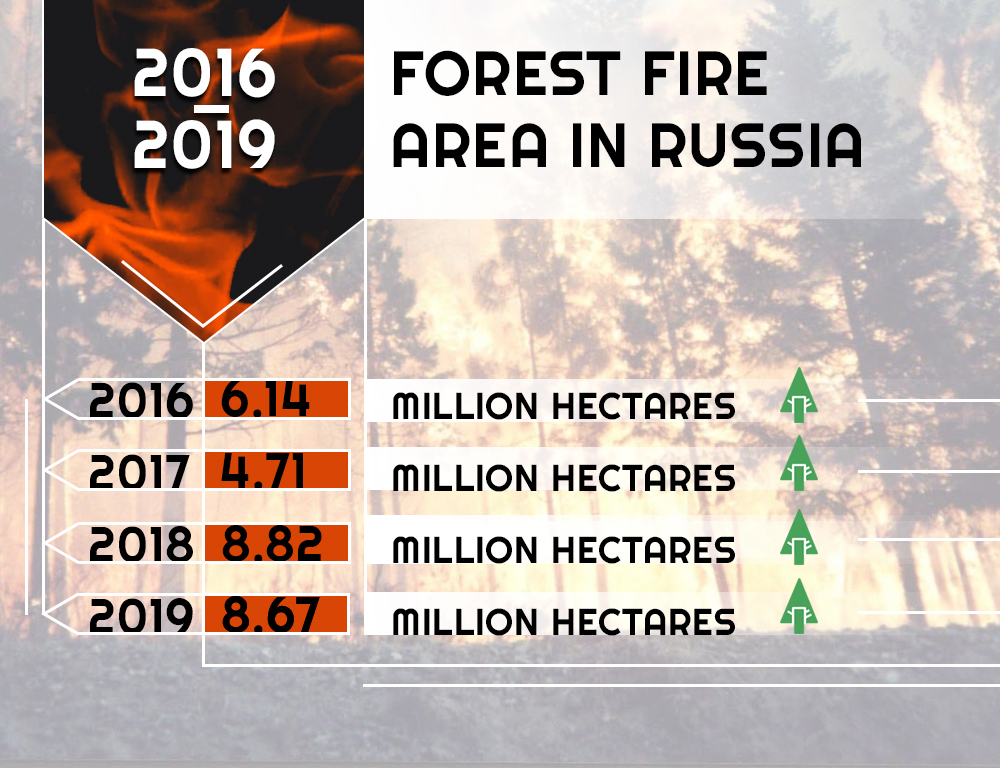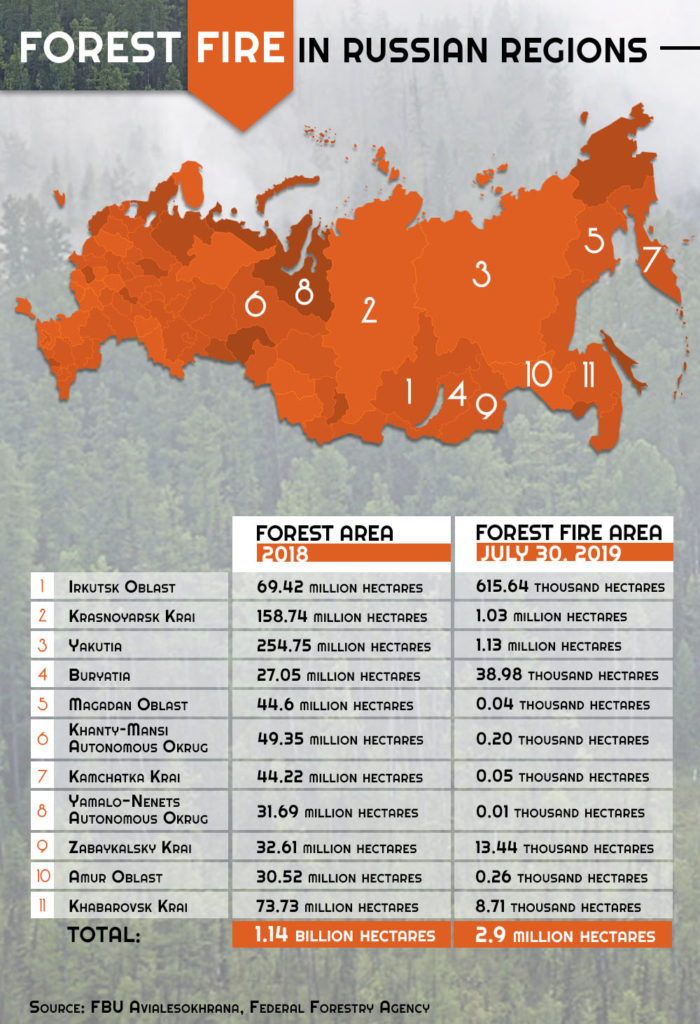This article was written in part using some data, materials, and opinion from RBK portal but, in the main, relying on FBU Avialesokhrana aviales.ru, one of the most modern ecological monitoring systems in the world which relies on daily satellite surveillance data.
The forests of Siberia are burning! Russian media are full of impressive headlines with terrifying photos, social media are abuzz, the Russian “creative class” is made far more anxious than by the Moscow protests.
The Earth is losing its lungs, which are destroyed by the Putin regime neglect.
“First they chopped everything down, then set it on fire to conceal it”, “they stole everything”, they want to hurt the whole civilized humanity,” “it would be better if Hitler captured Siberia”—these, sadly, are not jokes but some of the narratives being spread.
The number of posts in social media made in the last few weeks, mainly in Russian, about Siberian fires now runs into many hundreds of thousands. This level of activity is so unusual that Robert Mueller can’t sleep from burning envy. He didn’t have one tenth of such volume when it came to elections.
We’ve tracked the situation since the problem appeared in Russia in the first half of July of this year. Recently RBK, a pro-Western but de jure Russian publication, published an interesting overview. Where, with references to data, including from Greenpeace, it describes the actual state of fires in Siberia.
RBK writes that “the bulk of the negative reaction of social media users is linked to the scale of the fires”.
Many social media users are citing Greenpeace statistics: “according to Greenpeace, last year Russia lost to fires the greatest amount of forest in a decade—1.7 million hectares. This year, that record was exceeded by a factor of two!”
Greenpeace did not confirm this data and could not identify its source. Official statistics do not reveal any anomalous figures by comparison with previous years. In 2018, some 72.9 hectares of forests were destroyed in 2018 (a roughly similar amount, 72.2 million, was destroyed by insects). As of midnight of July 31, 2019, Russia had 147 active forest fires covering 197.1 hectares which were being actively combated, and 321 fires (covering 2.882 million hectares) under “constant observation” but not being extinguished because “there is not threat to populated areas and the cost of firefighting exceeds the predicted damage inflicted by the fire”.
The corresponding indicators for July 31 of last year are somewhat smaller but not by a factor of two, particularly if one considers the area covered by the fires—81 fires were being extinguished, covering 64 thousand hectares, and 205 were under observation (2.4 million hectares).
Moreover, starting in early 2019 and until the end of July, the area of all detected forest fires (which is not the same as the area of destroyed forest) amounts to 8.82 million hectares. It’s not greatly different from the same period last year—over the seven months of 2018, fires affected 8.4 million hectares (8.67 over the entire 2018).
When comparing the data on the current fire area (as of July 31) to the official data on the forest volume, in not a single Russian region is more than 1% of forests suffering a fire. The data from July 5, 2019 show that the fires are spreading with reduced speed, due to effective firefighting or weather. Of course, there’s the “snowflake” interpretation: everything burned down and we didn’t notice.
Greenpeace Russia provided RBC with its own fire assessment data. The organization agreed with the official Russian Forestry Service (Rosleskhoz) data concerning last year’s fires. This was confirmed to RBK by the head of the firefighting department of Greenpeace Russia, Grigoriy Kuksin. “The most objective official data currently existing in the country are in the 4ISDM format (the ISDM Rosleskhoz remote monitoring system). It is based on space surveillance data.” Kuksin explained that as of last year regional data is nearly exactly the same as ISDM data. This is due to the fact that the regions do not transmit their information in a timely manner, but catch up by the end of the year.
In other words, while this could become an anomalous fire year, there are no major deviations so far form average yearly statistics. The reason for the growing number of fires on the enormous territory of Siberia are obvious—it’s climate change. The inhabitants of central and southern Europe felt it on their skin when temperatures reached 36-40 degrees Celsius, while the inhabitants of Central Russia experienced only 7-11 degrees Celsius in early August.
However, data and common sense are not fashionable among the modern glamor society. Particularly when there is a chance to hype the theme of “all is lost, I am crying, please appreciate my concern.”
The number of social media posts concerning fires exceeded a million during the recent weeks. The information campaign was joined by many fashionable bloggers and publicists. Nearly all the posts by the popular bloggers and ordinary posters are accompanied by pictures of fires. But over 90% of photos used are from other fires. They are fires in Canada, California (USA), Greece, or other countries, or Russian fires but from 2011, 2013, and other past years. They have nothing to do with the current fires. In other words, the glamorous Russian content-makers did not even bother to check what they were publishing. There is no genuine journalism here, or any effort to work side by side with the firefighters. That is what the contemporary Russian office plankton and big city ne’er-do-wells amount to. /We know what we speak of, this is not an attack on Russians/
According to Medialogia data which RBK asked to analyze user activity concerning “Siberia forest fires” on social media and blogs during the last weeks, there was a sharp, nearly 100% increase in activity on 24-25 July.
And then, at the end of a decent article citing factual data, RBC’s content writers point out that the spike in activity took place “on the eve of an unsanctioned demonstration in support of Moscow opposition candidates, when the number of posts increased from 50.5 thousand to 95.4 thousand in a day”.
What does that mean? Did RBC’s content writers demonstrate the understanding of one of the key prerequisites for effective use of soft power, namely the need to promote anti-regime hysteria to the maximum when actions were put in motion, namely the protests? In this instance, the openly pro-Western protests in Moscow.
However, this is how RBC’s content writing team concludes the article (this is the article that was accessed on August 6, 2019):
“Using a large number of various social media accounts, hashtags, a certain number of influencers and an actual topic, one can greatly increase its weight”, according to PRT Edelman Affiliate General Director Gleb Sakhrai. “It can be made into the most important idea in the heads of people and make everything else recede. Forest fires are perfectly suited simply because ecological catastrophies are highly photogenic, and there is a huge amount of photos of such events on the internet.”








